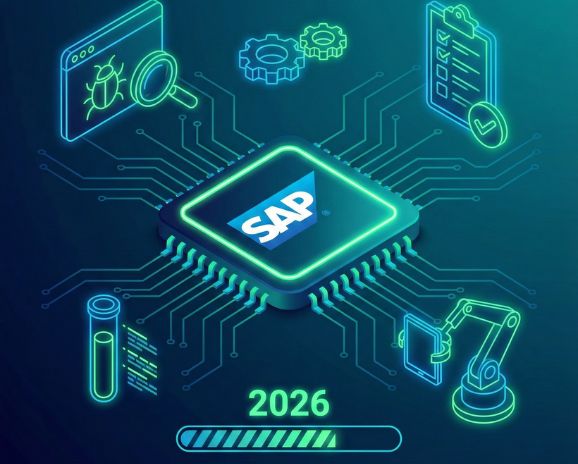The Ultimate Guide to SAP Testing Tools for 2026

SAP systems are the digital heart of modern enterprises, processing everything from financial operations to global supply chains. Consider this: a staggering 77% of the world’s transaction revenue touches an SAP system, making the reliability of these platforms absolutely non-negotiable.
For the QA Leads and SAP Center of Excellence managers tasked with safeguarding these critical operations, this reality presents a monumental challenge. The sheer complexity of SAP, where organizations customize between 30% and 60% of their modules, turns quality assurance into a high-stakes, resource-intensive bottleneck. Manual testing alone can devour over 30% of an SAP project’s budget, a huge figure in any software testing cost estimation.
This is where a strategic shift becomes essential. The right sap testing tools do more than just find bugs; they transform a project constraint into a quality accelerator. By embracing a modern sap test automation strategy, a major Coca-Cola bottler slashed its regression testing cycle from a grueling four weeks to just two days.
This guide provides a clear path to achieving similar results. We will break down the unique hurdles of SAP testing, establish a framework for evaluating tools, compare the top market solutions, and explore the future of SAP quality assurance.
Why Is a Modern SAP S/4HANA Testing Approach So Difficult?
Testing an SAP system is unlike testing any other application. Its unique architecture and central role in business create a perfect storm of challenges that demand a specialized sap s/4hana testing approach and sophisticated tools.
The Ripple Effect of Deeply Integrated Systems
SAP modules like Finance (FI), Sales & Distribution (SD), and Materials Management (MM) are not independent applications; they are deeply interconnected. A minor configuration change in one area can trigger unforeseen and catastrophic ripple effects in completely different business processes. Imagine a seemingly simple tax code update in FI. Without rigorous end-to-end testing, that small change could silently generate incorrect invoices in SD or disrupt inventory valuation in MM, causing direct financial and operational damage.

The Customization Conundrum
Nearly every SAP implementation is heavily customized with bespoke code and configurations to meet specific business needs. This high degree of customization renders standard, out-of-the-box test cases largely ineffective. Your testing strategy must be tailored to your unique environment to ensure complete test coverage and validate the custom logic that gives your business its competitive edge.
The Constant Cycle of Updates
The SAP ecosystem operates on a relentless update cycle, from major biennial S/4HANA upgrades to quarterly patches for cloud editions. Each release, no matter how small, introduces change and, therefore, risk. This constant flux puts an immense burden on teams to perform continuous regression testing, a time-consuming process designed to ensure that new updates do not break existing, critical functionality.
The “Green Light Lie” of Interface Testing
A particularly dangerous risk hides within data exchange interfaces like IDoc and EDI. An SAP system may report a successful technical status for a transaction (like “Status 53” for an IDoc), but this “Green Light Lie” only confirms a process ran—not that it ran correctly. Silent data mapping flaws can corrupt business outcomes, creating incorrect purchase orders or financial postings that standard tools were never designed to catch, a challenge that persists in S/4HANA environments.
The Test Data Management Nightmare
Finally, one of the biggest sources of project delays is the monumental effort required to create realistic, compliant, and referentially intact test data. Manually building a complete data set for an end-to-end Order-to-Cash process—from the initial quotation to the final accounting entry—is an error-prone nightmare that can cripple testing timelines.

The Modern SAP Testing Tool Checklist: 5 Must-Have Criteria
Choosing from the wide array of sap testing tools on the market can be overwhelming. To cut through the noise and make an informed decision, you need a clear evaluation framework. While the perfect tool depends on your organization’s unique landscape and goals, any modern, enterprise-grade solution must deliver on five non-negotiable criteria. Use this checklist to evaluate potential platforms and ensure you select a tool that is built for the future, not the past.

1. A Unified Platform, Not a Collection of Siloed Tools
The most effective sap test automation strategies rely on a single, unified platform that can test an entire business flow from start to finish. Modern business processes rarely live exclusively within SAP. A typical Order-to-Cash cycle might begin on a Salesforce web portal, move through your SAP S/4HANA system, and end with a notification on a mobile app. Stitching together separate tools for web, API, and SAP GUI testing creates integration gaps and process silos. A unified platform eliminates this complexity, allowing you to test the complete, cross-application journey in one seamless test flow while avoiding vendor lock-in.
2. An Intuitive Interface for Both Business and Technical Users
Legacy testing tools often require deep technical expertise, forcing teams to rely on specialists who could write complex VBScript or ABAP. Modern platforms democratize automation with intuitive, low-code/no-code interfaces. This empowers the people who know the business processes best—your business analysts and functional experts—to actively build and maintain automated tests without needing a programming background. This approach dramatically reduces learning curves and breaks down the silos between business and IT, embedding quality throughout the entire team.
3. Comprehensive Support for SAP and Non-SAP Technologies
A true enterprise tool must speak SAP fluently. This means providing native, out-of-the-box support for the full range of SAP interfaces, from the classic SAP GUI to modern, web-based SAP Fiori applications. But as mentioned, critical business processes extend beyond the SAP core. The tool must also seamlessly test SAP and non-SAP applications together, including web front-ends, mobile apps, APIs, and other packaged applications like Salesforce or Ariba. Without this capability, you can only test parts of a process, leaving dangerous and costly gaps in your quality assurance.
4. Intelligent Automation Powered by AI and Machine Learning
The leading sap testing tools now leverage Artificial Intelligence to move beyond simple, brittle script recording. AI is the key to optimizing sap s/4hana testing by making automation smarter, more resilient, and more efficient. Look for platforms that use AI for:
- Intelligent Impact Analysis: AI algorithms can analyze SAP transport requests and change logs to automatically identify which business processes are at risk and what needs to be tested, focusing your efforts where they matter most.
- Self-Healing Scripts: Modern tools use AI to recognize UI objects visually, much like a human does. This means that when an object’s underlying code changes during an SAP update, the test can “heal” itself, drastically reducing the time spent on manual script maintenance.
- Risk-Based Prioritization: AI can analyze historical defect data and production usage patterns to help you prioritize test cases based on business risk, ensuring that your most critical processes always receive the most attention.
5. Seamless Integration with ALM and DevOps Toolchains
Testing does not exist in a vacuum. To achieve true agility, your automation tool must integrate smoothly into your broader Application Lifecycle Management (ALM) and DevOps ecosystems. This means the platform must connect to SAP’s own management hubs like SAP Solution Manager or the newer SAP Cloud ALM for test planning and defect tracking. Furthermore, it must plug directly into your CI/CD pipeline (e.g., Jenkins, Azure DevOps) to enable continuous, automated testing where regression suites are triggered automatically with every new build or update.
Navigating the Market: A Comparative Analysis of Top SAP Testing Tools
Once you have your evaluation criteria, it’s time to analyze the market. The landscape of sap testing tools is diverse, populated by comprehensive enterprise suites, SAP’s own native offerings, and specialized niche players. Making an informed choice is more critical than ever, especially with the impending end of mainstream maintenance for SAP Solution Manager 7.2 at the end of 2027. This deadline is forcing every SAP customer to re-evaluate their entire toolchain, creating a perfect opportunity to adopt a modern, future-ready strategy.
While SAP provides native tools like Component-Based Test Automation (CBTA), they often have limitations in scope and usability, especially when testing end-to-end processes that involve non-SAP applications. As a result, many organizations turn to robust commercial platforms designed for complex, enterprise-wide automation.
The Leading Enterprise Platforms
Before we compare them head-to-head, here’s a brief overview of the major players:
- Qyrus: A modern, unified platform built from the ground up to handle web, mobile, API, desktop, data, and SAP testing without vendor lock-in. Its intuitive, low-code interface is designed for both business analysts and technical users, simplifying the automation of complex, end-to-end business flows.
- Tricentis Tosca: A market leader known for its powerful model-based test automation approach. It offers broad technology support and strong AI capabilities, though the platform has a reputation for a steep learning curve and higher costs.
- Worksoft Certify: A specialized codeless platform with a strong focus on validating end-to-end business processes from a business user’s perspective. It excels at automating complex workflows that span multiple enterprise applications like SAP and Salesforce.
- OpenText UFT One: A long-standing and highly versatile automation tool that supports over 200 different technologies. While powerful, especially in environments with legacy systems, it relies more on a scripted approach (VBScript) for advanced tasks and can be complex to maintain.
Head-to-Head: SAP Testing Tools Comparison Table
This table provides a consolidated, at-a-glance comparison to help you match a tool’s strengths to your organization’s specific needs.
| Criterion | Qyrus | Tricentis Tosca | Worksoft Certify | OpenText UFT One | SAP CBTA |
| Primary User | Business Analysts & QA Teams | Business Analysts, Automation Specialists | Business Process Experts, Functional Analysts | Automation Engineers, Technical Testers | SAP Functional Analysts |
| Technology Scope | Unified Platform (Web, Mobile, API, SAP GUI/Fiori, Salesforce) | Acquired Components for Web, Mobile, SAP (160+ tech) | SAP-centric with cross-app support (Oracle, Salesforce, Web) | Broad (200+ technologies) but less unified | SAP-specific (GUI, Fiori, Web Dynpro) |
| AI Capabilities | Autonomous Regression, Self-Healing, AI-assisted authoring | Strong (Vision AI, Risk-Based, Agentic) | Good (AI-powered stability) | Strong (AI Object Recognition) | Not a primary feature |
| End-to-End Testing | Natively designed for cross-platform flows | Strong, model-based approach | Core strength for business processes | Possible, but requires scripting expertise | Limited to SAP ecosystem |
| Ease of Use | Low-Code/No-Code, intuitive UI | Steep learning curve, requires certification | Scriptless, but can be complex to manage | Keyword-driven, but VBScript for complexity | Tightly integrated with SolMan, but complex setup |
| Key Consideration | No vendor lock-in, modern cloud architecture | Potential vendor lock-in, high TCO | Potential vendor lock-in, business process focus | Highly versatile for legacy systems | Free with SAP license, but limited Fiori support and maintenance ends 2027 |
The Qyrus Advantage: Solving Core SAP Challenges with AI-Powered Automation
Understanding the market is one thing; choosing a platform that directly solves your most pressing challenges is another. Qyrus is not just another tool in a comparison table; it is a comprehensive, AI-powered SAP testing platform engineered from the ground up to conquer the core complexities of the modern SAP ecosystem. This unified approach is how Qyrus enabled a leading automotive manufacturer to slash its overall SAP testing effort by an incredible 88%. It provides a single, homegrown solution for testing across SAP GUI, Fiori, APIs, and integrated applications like web and mobile, all from one place.

Go Beyond Reactive Testing with an AI-Driven Strategy
Effective SAP testing requires a smart strategy, not just more tests. Qyrus is built on the strategic “3 Cs” framework—focusing test efforts on the business processes that are most Critical, Complex, and have recently Changed. This risk-based methodology ensures that your resources are always aimed at the areas of highest business impact.
This strategy is powered by our advanced AI capabilities, including Autonomous Regression Testing (ARS). This is not just simple automation; it is an AI agent that plans, selects, and executes the optimal regression tests without human intervention. It leverages custom AI models, called SAP Scribe, that are fine-tuned to your specific SAP landscape, ensuring the most intelligent and efficient approach to optimizing sap s/4hana testing.
A Unified Platform That Eliminates Core SAP Pain Points
The true power of the Qyrus platform lies in how its features directly solve the challenges that plague SAP teams. We’ve designed specific modules to eliminate your biggest testing bottlenecks.
- Solving the Test Data Nightmare: Remember the monumental effort of creating test data? Our DataChain module makes it a thing of the past. You provide a single input, like a sales order number, and DataChain automatically scans the SAP system to map and extract every linked document in the end-to-end flow—from quotation to delivery to the final accounting entries. It then compiles this referentially intact data into a single, structured file, making test data creation up to 92% faster.
- Conquering the “Green Light Lie”: To expose the hidden risks in interface testing, our Document Exchange (IDoc/EDI) Testing module provides unmatched clarity. Its “Relationship Spotter” automatically links an incoming IDoc to the final business transaction it posted in SAP. It then provides a detailed, side-by-side comparison of the IDoc data against the posted document, instantly highlighting discrepancies that would otherwise go unnoticed.
- Automating Post-Update Validation: The weekend scramble to validate system health after maintenance is over. Robotic Smoke Testing (RST) automates these critical system checks. A single user can configure a suite of standard SAP transactions to run automatically, validating everything from system availability and background job status to external system communications, reducing a multi-team, hours-long effort to a few minutes.
- Pinpointing Performance Bottlenecks: For a successful sap s/4hana migration performance testing program, you need more than just response times. Our Performance Testing module provides deep technical insights by identifying the specific database tables that are causing delays in your custom code. This gives your developers the actionable intelligence they need to fine-tune enhancements and ensure the system performs under pressure.
The Next Frontier: Future Trends Shaping SAP Quality Assurance
The world of SAP testing isn’t standing still. The challenges and tools we’ve discussed are part of a rapidly advancing field where quality assurance is becoming more intelligent, more automated, and more deeply aligned with core business objectives. To build a resilient, future-proof strategy, it’s crucial to understand the emerging trends that will redefine SAP testing in the coming years.

Generative AI in Test Data and Script Creation
Generative AI is fundamentally transforming the most time-consuming aspects of test preparation. Instead of relying on risky and compliance-heavy production data, AI can now generate realistic, synthetic test data that mimics real-world patterns without containing any sensitive information. Advanced techniques like Generative Adversarial Networks (GANs) can analyze existing SAP data patterns and create new, statistically similar records that maintain referential integrity across modules like MM and FI.
Beyond data, GenAI is also automating test script creation. By analyzing business process diagrams (BPMN), user stories, and system configurations, AI systems can automatically generate comprehensive test scripts for both SAP GUI and Fiori environments. This powerful capability allows some organizations to see up to a 70% reduction in test creation and execution time for their SAP S/4HANA implementations.
Test Observability in Complex SAP Landscapes
We are seeing a paradigm shift from traditional monitoring to comprehensive Test Observability. This goes beyond simple pass/fail metrics to provide deep visibility into the internal state of applications based on three pillars: logs, metrics, and traces. For SAP, the most powerful aspect of this is distributed tracing, which allows teams to track a single transaction as it flows across the entire system landscape. This means you can follow a purchase order from its creation in MM through its financial impact in the FI and CO modules, providing unprecedented visibility into integration behavior and a powerful tool for root cause analysis.
Testing for Sustainability Metrics in S/4HANA
Increasingly, testing is no longer just about financial and operational data; it’s also about environmental impact. The integration of Environmental, Social, and Governance (ESG) metrics into SAP S/4HANA reflects a major shift in enterprise priorities. The SAP Green Ledger is at the forefront of this, enabling organizations to record and report environmental data with the same rigor as financial data.
This introduces new testing requirements. Your test strategy must now validate that carbon footprint data from SAP Product Footprint Management integrates seamlessly into procurement workflows and accurately tracks emissions at the product level. This involves validating data across Scope 1 (direct operations), Scope 2 (purchased energy), and Scope 3 (value chain) carbon footprints to ensure your organization can meet its sustainability reporting goals.
The Rise of Autonomous and Hyper-Automated Testing
The next evolution beyond standard automation is autonomous testing, which combines AI and machine learning to create systems that can adapt in real-time without human intervention. This is where hyper-automation comes in—the integration of AI, ML, and Robotic Process Automation (RPA) across the entire testing lifecycle. Predictions suggest that by 2027, hyper-automation will allow organizations to automate up to 90% of their testing processes, from test case generation and execution to reporting and defect management. This will free up QA teams to focus on high-level strategy and optimization rather than tactical execution.
Conclusion: From Testing Bottleneck to Quality Accelerator
The complexity of SAP S/4HANA systems demands more than just a traditional testing approach; it requires a strategic shift in how we think about quality assurance. To de-risk your implementation and accelerate your release cycles, you must move beyond slow, error-prone manual testing and siloed tools. The most effective path forward is a unified, low-code platform that empowers your entire team, avoids vendor lock-in, and can seamlessly test end-to-end business flows across all your enterprise applications. Adopting this modern approach is how one leading auto manufacturer successfully slashed their SAP testing effort by 88%.
The future of quality assurance is undeniably unified and AI-driven. The industry is rapidly moving away from brittle, high-maintenance scripts toward intelligent, codeless platforms that integrate seamlessly into a holistic quality strategy. By embracing this change, you can transform your testing function from a project bottleneck into a true catalyst for business innovation.
Stop letting siloed tools and manual testing slow you down. See how the unified Qyrus platform uses AI to accelerate your SAP releases with higher quality and lower risk. Book a personalized demo today!
Frequently Asked Questions (FAQs)
What is SAP testing?
SAP testing is the systematic process of validating that SAP software applications, customizations, and integrations perform accurately and meet all specified business requirements. It ensures that configurations, business logic, security, and workflows function correctly across the entire enterprise system.
Why is test automation critical for SAP S/4HANA?
SAP S/4HANA environments are incredibly complex and are updated frequently with new patches and releases. Manual testing simply cannot keep up with the pace and scale required, leading to slow release cycles and a high risk of production defects. Automation is essential for performing comprehensive regression testing quickly and efficiently, ensuring that system upgrades do not break core business functionality.
What is the difference between testing SAP GUI and SAP Fiori?
SAP GUI is a classic, desktop-based client used to interact with SAP systems. SAP Fiori is the modern, web-based user experience (built on HTML5/UI5) that provides a role-based, app-like interface. Testing GUI requires tools that can interact with desktop elements, while Fiori testing can be done with web automation tools. A truly comprehensive sap testing tool must support both interfaces to handle end-to-end processes that may start in Fiori and move to the GUI backend.
What is the role of SAP Solution Manager (SolMan) in modern testing?
SAP Solution Manager (and its successor, SAP Cloud ALM) serves as the central Application Lifecycle Management (ALM) hub for an SAP landscape. Its role is to manage test planning, requirements traceability, and defect orchestration. Modern automation tools do not replace SolMan; they integrate with it. SolMan acts as the “source of truth” for test management, while a powerful third-party tool like Qyrus provides advanced, cross-platform automation execution capabilities that go far beyond native tools like CBTA.
How does AI actually help in SAP testing?
AI provides tangible benefits by making testing smarter and more efficient. Its primary contributions are:
- Optimizing Scope: AI analyzes changes in SAP transports and system usage data to intelligently predict risk and recommend the most critical test cases to run, focusing effort where it’s needed most.
- Accelerating Creation: Generative AI can automatically create comprehensive test scripts from business process documents and generate realistic, compliant synthetic test data on demand.
- Reducing Maintenance: AI-powered “self-healing” technology allows test scripts to automatically adapt to UI changes in the SAP application, which dramatically reduces the manual effort required to maintain test suites over time.




